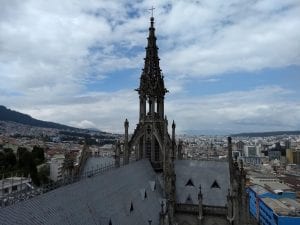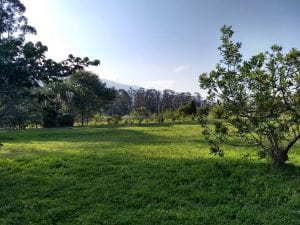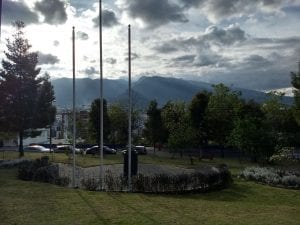Streams of smog spill out onto the street from big blue buses and yellow minivans labeled “C.I.A. Escolar.” I try to cover my breath, but it is too late: I can already feel the black tar making its home within my bronchioles. It is Saturday, and I have decided to join some of the other students on the program in the Centro Histórico to visit the Basilica, a tall, unfinished, and somewhat ill-fitting neo-Gothic church located at the top of a hill (it has been alleged by some locals that its completion will usher the end of the world).
I do not know what it is about the Centro Histórico—maybe the narrow streets and old stone architecture are compounding factors—but I find that the pollution there is particularly suffocating. And the rest of Quito is not great, either. My short walk to the local Trolebús stop, one I make almost every morning, is largely enough to remind me that I am far away from home.
There are many things that I have been able to get accustomed to while living here, like food and public transport patterns. However, I do not think that I will ever be able to get used to breathing in car contaminants. It is not something that you can really ever prepare for, despite any warning made before leaving. Just as you are at the mercy of the smell of an irresistible empanada, so are you to the plumes of smoke spiraling nearby. That is one unsettling reality of studying abroad: you are not necessarily in control of your environment. Yet it is also one with which you must inevitably make peace.
The top of the Basilica provides a much-needed breath of fresh air, although it is immediately undercut by the onset of vertigo-induced hyperventilation (having to climb up intensely narrow and rickety metal steps does not help). Still, I have tasted pure air, and in the uneasy ecstasy I cannot help but wonder what it would be like if it were always like this.
Sunday. Despite having gone to the Centro Histórico the day before, I am back with my host brother to see some of its more hidden features. But while I am walking, what stands out more to me than anything else is the sustained feeling of what I had seldom felt before—a pure, uncontaminated air streaming in and out of my lungs, uninterrupted. In many of the streets, there is not a single car. Instead, I see entire families riding bikes, rollerblading couples holding hands, and the occasional skateboarder. The reason? Since 2003, Quito has closed a 30-kilometer stretch of avenues, going north to south, for bicyclers and pedestrians. In 2009, “Ciclopaseo” became a weekly event.
It is shocking just how transformative the closure is on the general environment. I would say that there is a tangible sense of relief visible in the gait of every pedestrian (although to be fair, it might also be the fact that it is a Sunday). Instead of feeling stuffy and small, the streets feel like an extension of the sky. And not only is the smog gone, but also the noise pollution. The city is taking a great big breath.
I too am taking great big breaths, and with each one I feel a renewed sense of calm. But as we head back home and reenter the world of traffic, the feeling returns to the realm of distant memory. And upon opening my computer to search for pollution statistics, I am alarmed to see that Quito’s continual population growth has forecasted worse air quality by 2040. 35% of Quito’s streets already exceed their capacity by traffic, and that figure is rising.
But at the same time, there are new public transportation initiatives that could help mitigate some of these issues. The city has been constructing a new metro line that is expected to service 400,000 riders, although it is unclear when it will ever be completed (concerns have also been raised about how vertical it is—it is only one line that goes up and down the city). It has also been working on making improvements to the interconnectivity of the entire system.
It will be interesting to see how Quito chooses to tackle the problem in the coming decades. In the meantime, I will have to continue bearing the brunt of the smog. However, I would not say that it is all bad: it has also pushed me to seek out spaces of refuge throughout the city, like the Parque Metropolitano (a personal favorite of mine). Some photos are provided below:
Hasta la próxima!




